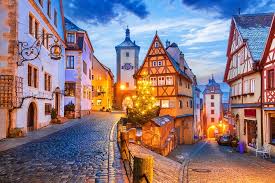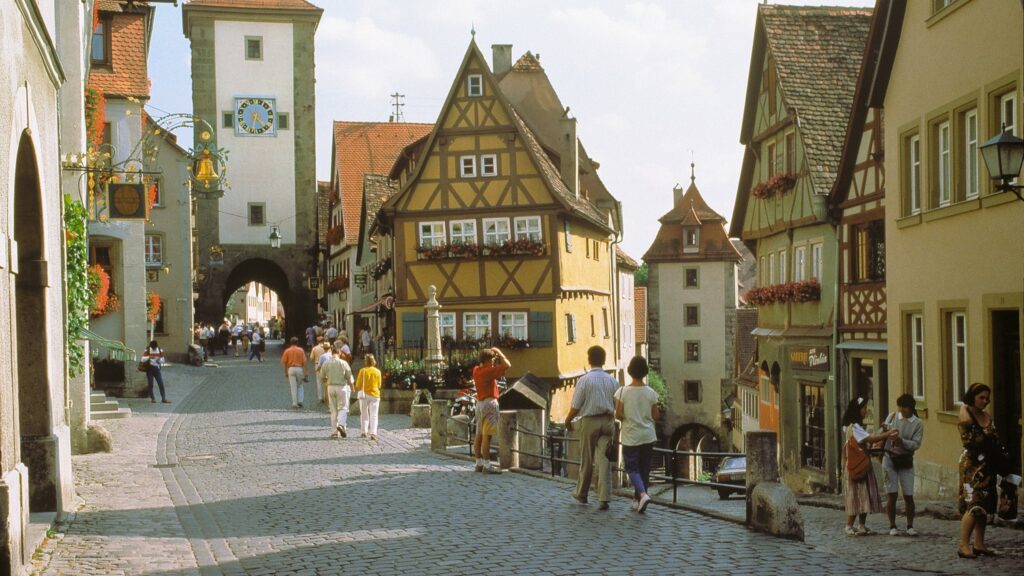Nestled along Germany’s Romantic Road, Rothenburg ob der Tauber looks as though it has stepped straight out of the pages of a medieval fairy tale. With its half-timbered houses, cobblestone lanes, and perfectly preserved town walls, Rothenburg is often described as a time capsule of Bavaria—a place where history has not only been remembered but carefully maintained. To wander its streets is to journey back several centuries, into a world of knights, merchants, and townsfolk whose legacy lives on in every stone.
A Glimpse into the Middle Ages
Rothenburg ob der Tauber, which translates to “Red Fortress above the Tauber,” first rose to prominence in the 13th and 14th centuries as a flourishing free imperial city. Its strategic position on trade routes allowed it to prosper, and much of its wealth was channeled into building grand fortifications, churches, and merchant houses.

Unlike many European towns that modernized rapidly or suffered extensive destruction during wars, Rothenburg has largely retained its medieval character. Walking through its intact city walls—complete with towers and gates—you can still imagine guards patrolling above, protecting merchants and villagers below.
Architectural Treasures
Rothenburg’s charm lies in its remarkable preservation of architecture. The townscape is dominated by:
- The Town Hall (Rathaus): A blend of Gothic and Renaissance design, it towers proudly over the central market square. Climbing its tower offers sweeping views of red rooftops and winding streets.
- St. Jakob’s Church: Home to the exquisite Holy Blood altarpiece carved by Tilman Riemenschneider, this church reflects Rothenburg’s medieval artistry at its peak.
- Plönlein Corner: Perhaps the most photographed spot in town, this charming fork in the road with a tilted half-timbered house has become an iconic symbol of Rothenburg worldwide.
- Medieval Walls and Towers: A complete circuit still surrounds the old town. Walking atop the ramparts is like stepping directly into the 15th century.
Every alley and building seems to whisper stories from a bygone age, offering a sense of continuity that few towns in Europe can rival.
A City of Living History
What makes Rothenburg special is that it is not merely a museum town—it is alive with traditions. Residents take immense pride in maintaining the character of their home. Festivals such as the Meistertrunk, which reenacts a legendary act of bravery during the Thirty Years’ War, bring history to life in the most vivid fashion.
The town also hosts lively Christmas markets, where visitors can experience centuries-old customs of Bavarian winter celebrations. Shops selling hand-crafted ornaments and the famous Käthe Wohlfahrt Christmas Village add to Rothenburg’s charm as a destination that celebrates tradition year-round.
A Survivor of Turbulent Times
Rothenburg’s status as a time capsule is also due to remarkable historical twists. During the Thirty Years’ War, it avoided total destruction by chance, while in World War II, American forces chose not to bomb the old town after learning of its cultural value. Local leaders then negotiated a peaceful surrender, sparing Rothenburg from devastation. These fortunate moments of history ensured that Rothenburg’s medieval beauty could endure into the modern age.
Rothenburg Today: Tourism and Preservation
Today, Rothenburg is one of Germany’s most visited medieval towns, drawing travelers from across the globe. While tourism plays a major role in the local economy, strict preservation laws ensure that modernization never erases its historic character. Cafés, shops, and guesthouses operate within centuries-old buildings, blending modern hospitality with medieval atmosphere.

For visitors, a stay in Rothenburg offers more than sightseeing—it is an immersive historical experience. Night Watchman tours lead guests through lantern-lit streets, recounting tales of sieges, plagues, and merchants. Museums such as the Medieval Crime and Justice Museum provide deeper insights into the complexities of medieval life.
Why Rothenburg Feels Like a Time Capsule
Rothenburg ob der Tauber endures not only because of its architecture but also because of the way it embodies Bavarian identity, heritage, and resilience. To stand in its market square or stroll along its walls is to feel history layered in stone and spirit. Unlike many places where the past is distant or abstract, Rothenburg makes history tangible, almost touchable.
For those seeking to experience the essence of medieval Bavaria, Rothenburg ob der Tauber is not just a destination—it is a journey back in time, a reminder of the richness of Europe’s cultural tapestry, and a living proof of what can be preserved when heritage is treasured.






